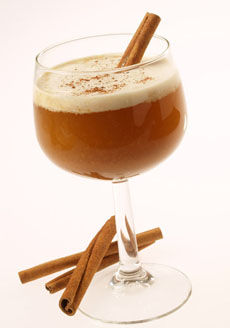__________________
*You’ll get more exciting flavor from fresh-ground nutmeg. Buy the nets in your supermarket and grate them with a fine grater like this one from Microplane, or a pepper grinder-style nutmeg grater that keeps your fingertips safe.
Preparation
1. WARM a small wine glass (you can do this in the microwave). Add tequila and hot apple cider. Stir.
2. FLOAT a half-inch of heavy cream on top. Grate nutmeg over the top and serve.
Apple Cider Preparation
1. ADD in a saucepan, 6 ounces of apple cider for each drink you’ll be serving.
2. ADD winter spices: a pinch of allspice, a few cloves, a cinnamon stick, and some orange peel. If you want more spiciness, you can add more later.
3. COOK over low heat for about 15 minutes, stirring occasionally. The cider should be warm but not bubbling.
4. TASTE for flavor and add more spice if desired.
5. REMOVE the pan from the stove. Strain out the spices and orange peel.
MORE WARM COCKTAIL RECIPES
Mulled Wine, Glogg & Hot Toddy (including alcohol-free mulled cider)
Spiced Apple Cider With Rum
Harvest Spiced Rum (it isn’t warm, but it’s a beautiful orange color)
TEQUILA TYPES
What’s the difference between an añejo, a blanco, and a reposado tequila?
There are five different expressions of tequila. Take a look.
TEQUILA TRIVIA: THE WORM
Why is there a worm in some bottles of tequila?
There isn’t! It is prohibited by law to put anything other than the tequila in a tequila bottle.
Worms are placed in some bottles of mezcal, a less refined spirit and a precursor of tequila. But it’s strictly for tourists. The better brands of mezcal are worm-free. The worm, by the way, is a larval form of a moth that lives on the agave plant, from which both mezcal and tequila are made.
CHECK OUT WHAT’S HAPPENING ON OUR HOME PAGE, THENIBBLE.COM.
|






